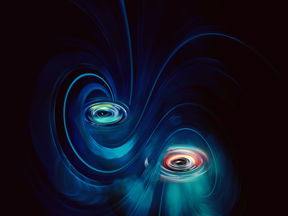Evading the uncertainty principle in quantum physics
New technique gets around 100-year-old rule of quantum physics for the first time

Aalto University Professor Mika A. Sillanpää, his team and collaborators at the University of New South Wales in Canberra, Australia, have won the Physics World 2021 Breakthrough of the Year. The prize was awarded for establishing quantum entanglement between a pair of macroscopic drumheads – two mechanical resonators that were tiny but still much larger than the subatomic particles that are usually entangled. The award has previously been given for the first direct observation of a black hole and for the detection of gravitational waves, which also received a Nobel Prize.
By showing that even large objects can be in an entangled quantum state, this research advances our understanding of the division between the quantum and classical domains. ‘It is not clear if an unknown property in nature limits the quantum properties of very large objects,’ says Sillanpää. The entangled drumheads offer scientists new tools for probing the boundary and identifying if there are such limitations. The entangled resonators could also have practical applications as quantum sensors or nodes in a quantum network.
The researchers were able to simultaneously measure the position and the momentum of the two drumheads. This should not be possible according to the Heisenberg uncertainty principle. ‘In our work, the drumheads exhibited a collective quantum motion. The drums vibrated in an opposite phase to each other, such that when one of them was in an end position of the vibration cycle, the other was in the opposite position at the same time,’ explains the lead author of the study, Laure Mercier de Lépinay, who will become an assistant professor at Aalto at the beginning of January 2022. ‘In this situation, the quantum uncertainty of the drums' motion was cancelled if the two drums were treated as one quantum-mechanical entity.’

Sillanpää’s group is at the forefront of the handful of groups carrying out similar research around the world. ‘The experiments are extremely difficult and time consuming. You must have a lot of patience to be able develop and design new recipes for the best research settings. The measurements rely on both engineering and intuition – just randomly doing something related takes you nowhere,’ he says.
With funding from the European Research Council, Sillanpää’s team will use much larger drumheads – together with tiny gold spheres and ultralow temperatures – to tackle a hundred-year-old physics mystery. ‘We will continue this research and try to observe the effect of gravity in the quantum-mechanical system. This represents one of the major open questions in physics,’ Sillanpää says.
Caspar Ockeloen-Korppi was also part of the award-winning research team. Matt Woolley, a senior lecturer at the University of New South Wales, was responsible for developing the theoretical model for the experiment. The prize was shared with a research group at the National Institute of Standards and Technology (NIST) in the United States which also demonstrated quantum entanglement of vibrating drumheads, though they used a different approach than the Aalto-South Wales collaboration.
Margaret Harris, the online editor at Physics World says that ‘both teams showed that they could create quantum entanglement between two vibrating drumheads. Because these drumheads are macroscopic objects, measuring 10 or so microns across, the fact that they can be entangled challenges conventional notions about where the quantum world ends and the everyday classical one begins. Research at this increasingly fuzzy boundary has already produced some amazing results, and I and my colleagues in the Physics World editorial team are looking forward to more.’
The research was carried out using OtaNano, a national open access research infrastructure. Sillanpää’s group is part of the Quantum Technology Finland (QTF) national Centre of Excellence and InstituteQ, the Finnish quantum institute. Sillanpää is Professor at the Aalto Department of Applied Physics and the head of the Quantum Nanomechanics group.
Physics World: Quantum entanglement of two macroscopic objects is the Physics World 2021 Breakthrough of the Year
Physics World: Vibrating drumheads are entangled quantum mechanically
Physics World Top 10 Breakthroughs for 2021 finalists
Top 10 Breakthroughs of 2021 podcast
Article: Vibrating drumheads are entangled quantum mechanically

New technique gets around 100-year-old rule of quantum physics for the first time

The team is trying to solve a hundred-year-old mystery of physics with the help of small gold spheres and extremely low temperatures. The observation of tiny gravitational forces between vibrating spheres may solve the mystery.



